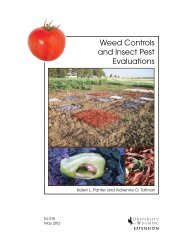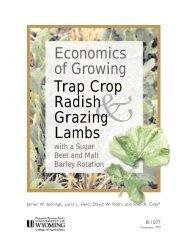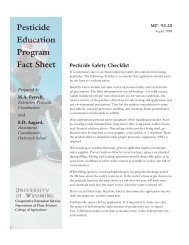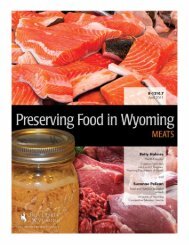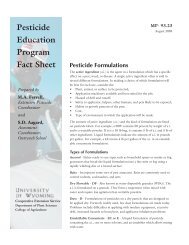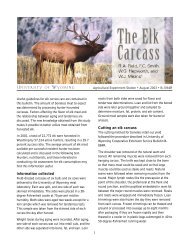Pesticide Labeling
Pesticide Labeling
Pesticide Labeling
Create successful ePaper yourself
Turn your PDF publications into a flip-book with our unique Google optimized e-Paper software.
cide to a crop or site not listed on the label. If<br />
applied to a pest not included on the label, the<br />
applicator is responsible for the results of that<br />
application. Some pesticide labels indicate use<br />
is limited to certain categories of commercial<br />
applicators.<br />
Some directions for use that pesticide users<br />
must obey are contained in documents that are<br />
only referred to on the labeling. Such instructions<br />
include EPA or other government regulations<br />
or requirements concerning the safe use<br />
of the pesticide product. For example, EPA has<br />
adopted or is considering new requirements<br />
concerning: groundwater protection; endangered<br />
species protection; pesticide transportation,<br />
storage, and disposal; and worker protection.<br />
One sentence or paragraph may be the<br />
only notice you will receive that additional use<br />
directions are required in order for the product<br />
to be used in compliance with its labeling. You<br />
must determine whether you are affected, locate<br />
the applicable directions for use, determine<br />
how to comply with the instructions and requirements<br />
in the directions for use, and comply<br />
with those instructions and requirements.<br />
Most documents referred to on the label should<br />
be available at your local county Cooperative<br />
Extension office.<br />
Storage and Disposal Precautions<br />
Every pesticide should be stored and discarded<br />
correctly. The label has directions for storing<br />
the pesticide to prevent contamination of other<br />
products. Storage temperatures are stated on<br />
the label to prevent overheating or freezing.<br />
The label either explains procedures for disposing<br />
empty containers or tells the user to follow<br />
procedures designated by state law. Directions<br />
on how to dispose of waste when rinsing equipment<br />
and containers also are included.<br />
Reading the Label<br />
Before you buy a pesticide, read the label to<br />
determine:<br />
· whether it is the pesticide you need for the<br />
specific crop and pest<br />
· whether the pesticide can be used safely under<br />
the application conditions<br />
Before you mix the pesticide, read the label to<br />
determine:<br />
· what protective equipment you should use<br />
· what the pesticide can be mixed with (compatibility)<br />
· how much pesticide to use<br />
· the mixing procedure<br />
Before you apply the pesticide, read the label to<br />
determine:<br />
· what safety measures you should follow<br />
· whether protective clothing and equipment<br />
are needed<br />
· where the pesticide can be used (livestock,<br />
crops, structures, as examples)<br />
· when to apply the pesticide (including the<br />
waiting period for crops and animals)<br />
· how to apply the pesticide<br />
· whether there are any restrictions for use of<br />
the pesticide<br />
Before you store or dispose of the pesticide or<br />
pesticide container, read the label to determine:<br />
· where and how to store the pesticide<br />
· how to decontaminate and dispose of the<br />
pesticide container<br />
· where to dispose of surplus pesticides<br />
If you have trouble reading or understanding<br />
the pesticide labeling, contact your local<br />
county Cooperative Extension Office or other<br />
knowledgeable person.<br />
4



